 Image search results - "fabrics" Image search results - "fabrics" |

Then we go to the indigo vats. They are heated with charcoal made with wood from trees on their hill. Each vat has a different indigo density.
|
|
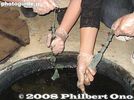
We started with a vat having a low density of indigo. We dip the handkerchief for 15 sec., wring it, then expose it to the air. The indigo dye is actually a murky brownish-yellow color, but turns blue when exposed to the air.
|
|
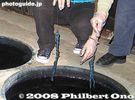
We dipped the handkerchief in multiple vats, each successive vat had a higher density of indigo. The more vats we dip the fabric in, the darker the color.
|
|
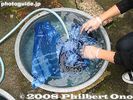
After the indigo dip, water washed the handkerchief.
|
|
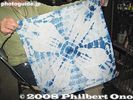
One result... All the designs are unique. We held the wet handkerchief in front of a kerosene heater and it dried quickly.
|
|
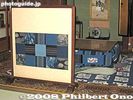
A room inside the shop had indigo fabrics everywhere. It takes years to learn the craft of indigo dyeing, including growing the plants. Like many other traditional crafts, this shop is uncertain who will take over and continue traditional indigo dyeing.
|
|

Indigo placemats on stairs. It's possible for the shop to handle up to 20 people to try indigo dyeing in their shop. Call 0748-75-0128. Address: Shimoda 1530, Konan-shi, Shiga
|
|
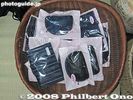
Pouches, etc., made of indigo fabric, for sale. Coming to this place really made me aware of how beautiful the indigo color is. Take a bus or taxi from Kosei or Mikumo Stations on the Kusatsu Line. Get off at Shimoda and walk 50 meters. Parking also avail
|
|
|
|







